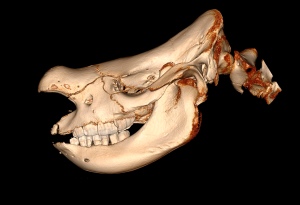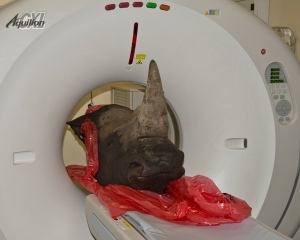The role of research in conservation
In my quest to learn more about rhinos, I became disheartened when I discovered that there is so little research published about rhinos, even basic anatomy is not entirely known. We are essentially trying to save a species that we do not have much basic information about.
Rhinos that are poached do not necessarily always die. Poachers often dart rhinos with a concoction of tranquilizers that leaves them immobile while their horn is being hacked off. In such cases, Dr. Johan Marais, equine and wildlife surgeon at Onderstepoort veterinarian facility and faculty of veterinarian science at University of Pretoria, uses his expertise to save rhinos that still have a chance of survival. Dr. Marais’ research has focused on rhino sinuses that have become damaged and traumatized as a result of bullets going through the rhino’s head.
Using a CT (computed tomography scanner) and software to build 3D images of the white rhino skull, Dr. Marais is able to locate if the bullet has traveled through paranasal sinuses or through important structures of the brain. Being able to identify the location of the bullet in relation to the rhino’s skull has helped save many rhinos that otherwise may not have had a chance of survival. Although it is not ideal if a bullet travels through the sinuses, it is still plausible for the rhino to heal with treatment, as the sinuses are only filled with air.

“While working on the faces of these rhinos, we realized that the horn and face are extremely sensitive, even while they are under immobilization,” Dr. Marais told me.
Using the software that builds images of the white rhino’s skull, Dr. Marais located a nerve within the horn area, and now performs a “nerve block” by injecting local anesthesia over the nerve, decreasing the feeling and sensitivity in the rhino’s face. It is possible to perform surgery on the rhino without the rhino feeling any sensation on that part of the face.

Dr. Marais and his team are pioneers in the poaching crisis, saving rhinos that would have otherwise been added to the growing list of casualties. The research based on Dr. Marais’ work will be published in a scientific journal later this year, and will certainly benefit rhinos that have been victimized by poaching. Approximately 1,215 rhinos were killed in 2014, equating to one rhino killed every eight hours. It is a race against extinction for rhinos, and every life matters.